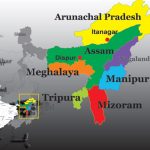In India’s Northeast, Peace Talks Teeter as Separatist Leader Issues Ultimatum
In a significant escalation of tensions, the 90-year-old leader of one of India’s oldest insurgencies has threatened to resume armed resistance, potentially unraveling decades of peace negotiations in the country’s northeastern state of Nagaland.
T. Muivah, general secretary of the National Socialist Council of Nagaland (I-M), has accused the central government of “deliberately betraying” the 2015 Framework Agreement, marking another critical juncture in a conflict that has persisted since India’s independence.
Core Demands and Deadlock
The peace talks have stalled over two non-negotiable demands: a separate flag and what the NSCN (I-M) terms as “Naga constitution” – elements the group considers “indispensable and irrevocable parts of the recognised sovereignty.” The latest round of discussions, held in Delhi on October 7-8, ended in deadlock when Muivah proposed a “third-party intervention” in the peace process.
The Constitutional Question
The legal basis for these privileges stems from Article 371(A) of the Indian Constitution, which confers special provisions on Nagaland. These include protections for:
- Religious or social practices
- Naga customary law and procedure
- Administration of civil and criminal justice involving Naga customary law
- Ownership and transfer of land and its resources
However, analysts suggest the central government may be reluctant to consider NSCN (I-M)’s demands given the abrogation of Article 370 that previously granted special status to Jammu and Kashmir.
Complex Tribal Dynamics
The situation is further complicated by Nagaland’s demographic makeup. Tribals constitute 89% of the state’s population, with approximately 7% being Tangkhul Nagas. Some within the community view Muivah and his loyalists as “outsiders” who are allegedly attempting to usurp land and resources legally belonging to the Nagas of Nagaland, according to a June 2023 statement by the Working Committee of NNPGs.
Historical Context and Recent Developments
The Naga peace process has seen multiple pacts and setbacks. Following the Shillong Accord of 1975, NSCN split into two groups: NSCN (I-M) led by Isak Chishi Swu and Muivah, and NSCN (Khaplang). After Swu’s death in 2017, leadership dynamics shifted significantly.
Recent developments include:
- The Modi government’s 2015 Framework Agreement with separatist outfits
- A meeting chaired by Nagaland Chief Minister Rio with various stakeholders
- Reports of NSCN (I-M) allegedly moving arms from their current locations near Dimapur to prepare for potential conflict
Trust Deficit
A significant challenge facing the peace process is what appears to be growing mistrust. Some NSCN (I-M) insiders suspect attempts to infiltrate the rebel group by Indian security agents. Adding to the complexity, earlier this year, multiple senior functionaries reportedly rebelled against military chief Anthony Ningkhan Shimray, who had been released from prison in 2016 to facilitate the peace process.
Looking Ahead
Despite Muivah’s advanced age and health issues, he continues to function as the most powerful leader in the Naga rebel movement. While some analysts fear the government might prefer to sign a peace accord with NNPGs, others warn that such a move could result in renewed violence.
Insurgency experts believe it would be challenging for NSCN (I-M) to wage an all-out war against India, noting that the situation in the Northeast has drastically changed in the last decade. Major rebel groups in Assam, Tripura, and Manipur have largely accepted peace and development initiatives, suggesting a regional trend toward resolution rather than conflict.
The resolution of this decades-old conflict now hinges on finding common ground between preserving unique Naga identity and maintaining India’s constitutional integrity – a balance that has proven elusive for over half a century.






